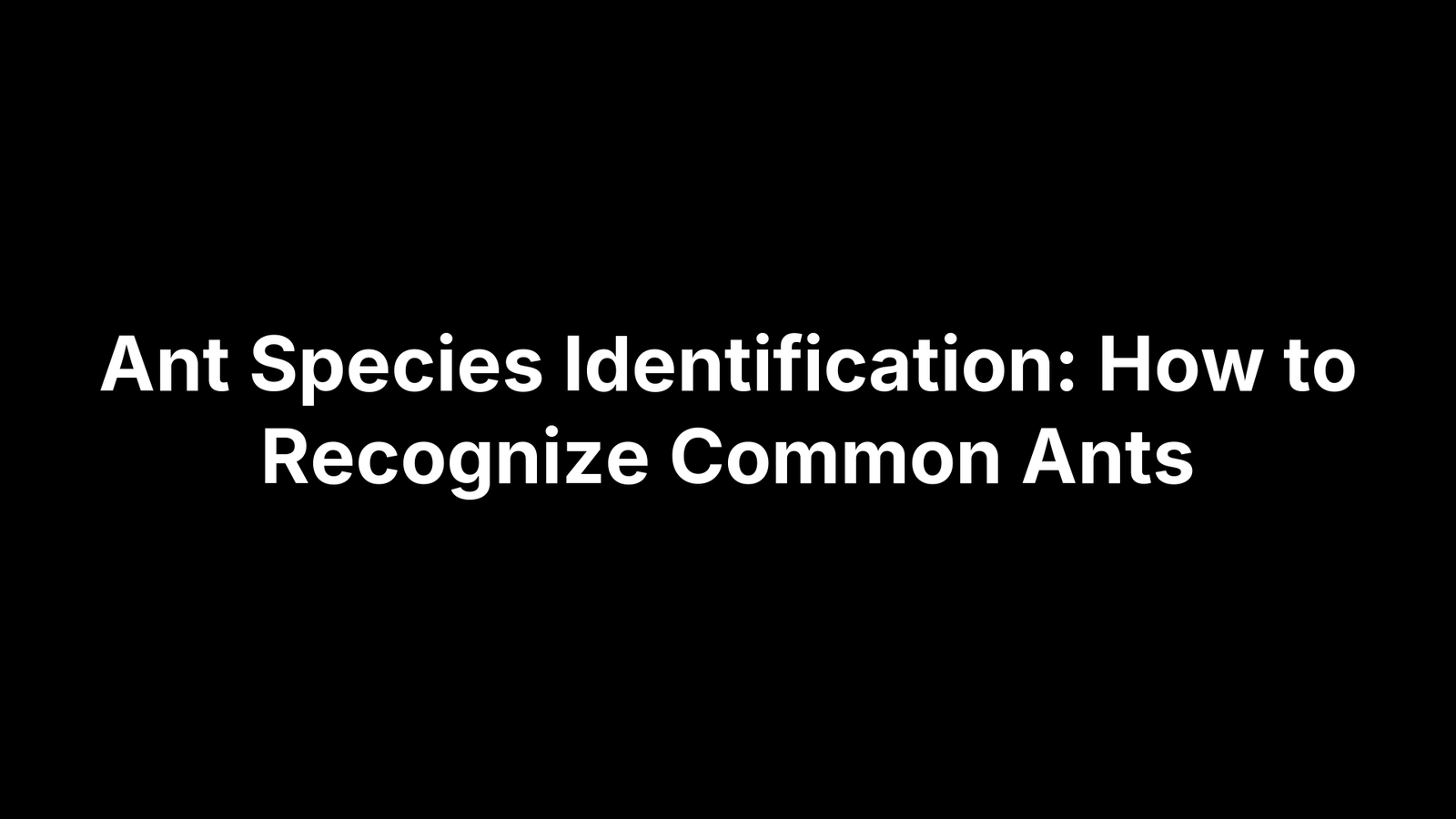Ants share kitchens, lawns, and office break rooms, yet each species responds to control products in its own way. Spraying random insecticide on a trail usually ends with the colony rebuilding somewhere else—often inside your walls. The real first step is figuring out which ant you’re fighting. Sugar-loving odorous house ants shrug off the baits that knock out protein-hungry fire ants, and carpenter ants demand a completely different approach again.
This 7-to-8-minute guide walks you through specimen collection, the four body features every pro checks, behavioral clues, and a photo-matching section covering the seven species responsible for almost every household complaint in the United States. Follow along and you’ll finish with a confident ID, a control plan tailored to that species, and a clear signal for when it’s smarter to bring in a Redi Pest Control technician than to keep experimenting on your own.
Step 1: Confirm You’re Really Dealing With Ants, Not Termites or Other Insects
Winged swarms in spring, tiny brown workers on the countertop—at a glance they all look “ant-ish.” That snap judgment leads homeowners to buy the wrong bait or, worse, ignore a hidden termite colony. Before you break out the pesticides, verify that you’re actually looking at ants.
Universal ant traits you should see:
- Distinct elbowed antennae
- Pinched “waist” (one or two nodes between chest and abdomen)
- Hardened, slightly shiny exoskeleton
- Organized trails or clusters of workers
Quick comparison:
| Trait | Ants | Termites | Earwigs |
|---|---|---|---|
| Waist | Narrow, nodes present | Uniform width | Uniform width |
| Antennae | Elbowed | Straight, bead-like | Short, straight |
| Wings (if any) | Front pair longer | All four equal | None |
| Signature feature | Segmented workers | Pale bodies | Forceps tail |
Action tip: Use a flashlight and your phone’s zoom to capture a clear side-profile photo; that single image often settles the question.
Visual Red Flags That Shout “Not an Ant”
- Straight, beaded antennae and equal-length wings = termite.
- No waist plus a visible stinger = small wasp.
- Forceps on the abdomen = earwig.
Mis-ID wastes time, money, and lets the real pest keep multiplying.
Step 2: Safely Collect and Observe a Specimen Without Getting Bitten or Stung
Ant species identification starts with a whole, undamaged insect. Grab a pair of latex gloves and coax a worker onto a white index card using a soft paintbrush or the edge of another card—never your fingers. Tilt the card so the ant walks into a clean pill vial or small jar with tiny air holes.
Recommended toolkit:
- 10× hand lens or phone macro clip
- White card or paper as background
- Ruler or measurement app for scale photos
Resist the urge to squish the ant. Crushing releases alarm pheromones that summon nest mates and flatten the very body parts you need to inspect. If you suspect fire ants or aggressive harvesters, scoop a tablespoon of their soil along with a few workers, snap the lid on tight, and place the container in the fridge for five minutes; the cold slows them without damage, giving you a safe window to observe.
Field Notes to Record Before the Ant Gets Away
- Date and time
- Exact location (under sink, patio crack, office carpet)
- Nearby food source or moisture
- Weather conditions at discovery
- Behavior: lone scout, steady trail, carrying prey, showing aggression
Good notes make matching the specimen to species behavior in Step 4 a breeze.
Step 3: Examine Key Physical Characteristics Under Magnification
Put the chilled worker on a white card, switch on a desk lamp, and look through a 10× lens. Four body clues—nodes, thorax shape, antenna configuration, and surface details—separate nearly every household ant. Jot what you see; these notes steer you to the right species list in Step 5.
Count the Nodes (Petiole Segments)
Tilt the ant sideways and focus on the narrow “waist” between chest and abdomen.
- One raised bump = a 1-node ant (e.g., carpenter, odorous house, Argentine).
- Two distinct bumps in a row = a 2-node ant (e.g., pavement, pharaoh, fire).
Picture a tiny camel with one or two humps—that’s effectively what you’re scoring.
Inspect the Thorax (Pronotum) and “Hump” Profile
View the ant from the side. A smoothly rounded back usually signals carpenter or Argentine ants. Thoraxes with visible dips or sharp spines point toward pavement or fire ants. Angle the light; shadows make the contour stand out.
Check Antennae and Mandibles
Count segments if possible: 12 in most species, 11 with a 3-segment “club” for pharaoh ants. A sharp right-angle “elbow” is universal, but crazy ants show an exaggerated curve with antennae longer than their bodies. Oversized jaws hint at carpenter ants; slender, sickle-shaped ones fit crazy ants.
Note Color, Size Range, and Body Hair
Record approximate length: 1⁄16″ (2 mm) to ½″ (13 mm). Color alone misleads—carpenter ants can be all black or two-toned—but it narrows options when paired with node count. Fine golden hairs across the abdomen are a giveaway for odorous house ants, while a glossy, hairless sheen suggests Argentine ants.
Step 4: Observe Behavior and Nesting Habits for Additional Clues
Anatomy gets you close, but the way an ant eats, travels, and builds finishes the ID puzzle. Spend five minutes watching the live colony; those habits rarely lie and often separate look-alike species.
Foraging Patterns and Food Preferences
- Sugar trails to spilled soda point toward odorous house or Argentine ants.
- Grease-seeking lines around stoves usually signal pavement ants.
- A protein switch—sugary in spring, oily in summer—is classic pharaoh behavior.
- Erratic, fast-moving individuals with no set trail = crazy ants.
Nest Locations and Structures
- Soil mounds with no central hole, crumbly when kicked: red imported fire ants.
- Fine dirt pushed from cracks in sidewalks: pavement ants.
- Moisture-softened wood that sounds hollow: carpenter ants.
- Warm wall voids near pipes or appliances: pharaoh and Argentine ants.
Seasonal Activity and Swarming Times
- Carpenter ants swarm on warm, humid spring nights.
- Fire ants launch mating flights after late-summer rains.
- Pavement and odorous house ants peak mid-summer but stay active indoors year-round.
Tracking these calendars helps validate your ant species identification before treatment.
Step 5: Match Your Findings to the 7 Most Common U.S. Ant Species
You now have measurements, node counts, and behavior notes—time to plug those clues into specific species. The cheat sheets below focus on the ants that account for roughly 90 percent of customer calls to pest-control companies nationwide. Scan for the combination that mirrors your field notes; precise ant species identification here determines which bait or treatment will actually work.
Carpenter Ant (Camponotus spp.)
- Size: 6–13 mm (¼–½″), largest common house ant
- Nodes: single; evenly rounded thorax
- Color: black, dark brown, or two-toned red/black
- Signs: sawdust-like frass, faint rustling in walls, nocturnal scouts
- Control angle: eliminate moisture and treat wood voids; baits alone rarely finish the job
Odorous House Ant (Tapinoma sessile)
- Size: 2.4–3.3 mm
- Nodes: single, hidden under abdomen edge
- Color: dark brown to black; fine golden hairs
- Claim to fame: smells like rotten coconut when crushed
- Control angle: sweet gel baits indoors, perimeter exclusion outside
Pavement Ant (Tetramorium immigrans)
- Size: 2–3 mm
- Nodes: two; thorax with tiny spines and parallel head grooves
- Nest: under concrete slabs, along driveways, basement slabs
- Behavior: slow-moving columns, spring “wars” with neighboring colonies
- Control angle: protein or grease baits plus crack-and-crevice dusts
Pharaoh Ant (Monomorium pharaonis)
- Size: 1.5–2 mm, almost translucent
- Nodes: two; 3-segmented club on antennae
- Habitat: heated structures year-round—hospitals, apartments, offices
- Trickiness: “budding” colonies split when stressed, making sprays counter-productive
- Control angle: only slow-acting baits; never contact sprays
Argentine Ant (Linepithema humile)
- Size: 2.6–3.2 mm
- Nodes: single; smooth, hair-less sheen
- Behavior: super-colony trails hundreds of feet along edges and wires
- Preference: sweets and moisture; invades kitchens after rain
- Control angle: perimeter liquid treatment plus high-volume sugar baits
Crazy Ant (Paratrechina longicornis)
- Size: 2.2–3 mm
- Nodes: single; extremely long legs and antennae
- Movement: erratic, no defined trail lines
- Nest: clutter, potted plants, even electronics
- Control angle: non-repellent sprays and protein/sugar dual baits
Red Imported Fire Ant (Solenopsis invicta)
- Size: 2–6 mm, polymorphic workers
- Nodes: two; coppery head, dark abdomen
- Nest: dome mounds with no central opening, aggressively defended
- Risk: painful sting forming white pustule; medical concern for pets and kids
- Control angle: broadcast bait plus direct mound drench for quick knock-down
Quick Side-by-Side Comparison: Fire Ant vs. Carpenter Ant
| Feature | Red Imported Fire Ant | Carpenter Ant |
|---|---|---|
| Size range | 2–6 mm | 6–13 mm |
| Waist nodes | Two | One |
| Defense | Stings (venom) | Bites, mild formic acid |
| Nest type | Soil mounds, sun-lit lawns | Moist or decayed wood galleries |
| Treatment urgency | High—medical & lawn damage | High—structural damage |
With these profiles in hand, most homeowners can pin their specimen to a single name and move confidently to treatment or professional help.
Step 6: Validate Your Identification With Reliable Resources and Tech Tools
Before you shop for bait, confirm your findings with a second source. Double-checking now prevents wasted money and, in the case of fire ants, painful mistakes.
Printed and Online Identification Keys
Use AntWiki’s regional dichotomous keys or your state’s university-extension PDF. Work through the yes/no prompts in order; when only one species fits every box, you have a solid ID.
Mobile and Desktop Apps for On-the-Go ID
AntKey Mobile and iNaturalist let you snap quick photos and tap community or AI expertise. For best results, photograph the ant’s top, side, and head against a plain white card.
Community Forums and Extension Offices
Post those images to r/ants, BugGuide, or email your county extension office—include location and node count for faster replies. Send physical specimens only for invasive-species screenings or out-of-range fire-ant reports.
Step 7: Next Steps After Correct Identification
Match control to the species you’ve just confirmed. Sugar-loving ants such as odorous house or Argentine fall for sweet gel baits, while protein baits and grease formulas tempt pavement and pharaoh ants. Carpenter ants demand wood-void treatments or structural repairs, not kitchen baits. Fire ants? Broadcast a fast-acting bait, then drench each mound to wipe out the queens.
Prevention checklist:
- Keep counters crumb-free and store food in sealed containers
- Fix leaks and run dehumidifiers to cut indoor moisture
- Caulk cracks around pipes, windows, and foundation joints
- Trim shrubs and mulch so nothing touches the house within 18″
Call a professional if colonies are sprawling, stings become frequent, or you find frass and hollow wood—signs a DIY approach may no longer cut it. Redi Pest Control technicians have the tools and permits to finish the job safely.
Pulling It All Together
Correct ant species identification saves time, money, and frustration. Follow this quick recap to keep every step straight:
- Confirm the insect is an ant—not a termite, earwig, or tiny wasp.
- Collect an intact worker safely with a vial, brush, and field notes.
- Under 10× magnification, record node count, thorax profile, antenna segments, color, size, and body hair.
- Observe foraging patterns, preferred food, nest location, and seasonal swarms.
- Match those clues to the seven most common U.S. species cheat sheets in Step 5.
- Double-check your pick with AntWiki keys, mobile apps, or a county extension expert.
- Choose the control method designed for that species.
These seven steps work in kitchens, lawns, apartments, and warehouses alike. If you’d rather skip the trial-and-error and be certain it’s handled right, schedule a free inspection with the team at Redi Pest Control LLC. Precise ID today means zero ants tomorrow.


